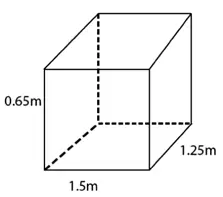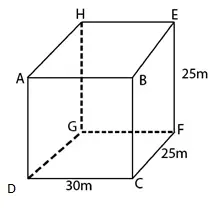Exercise 13.1 Page No: 213
1. A plastic box 1.5 m long, 1.25 m wide and 65 cm deep, is to be made. It is to be open at the top. Ignoring the thickness of the plastic sheet, determine:
(i)The area of the sheet required for making the box.
(ii)The cost of sheet for it, if a sheet measuring 1m2 costs Rs. 20.
Solution:

Given: length (l) of box = 1.5m
Breadth (b) of box = 1.25 m
Depth (h) of box = 0.65m
(i) Box is to be open at top
Area of sheet required.
= 2lh+2bh+lb
= [2×1.5×0.65+2×1.25×0.65+1.5×1.25]m2
= (1.95+1.625+1.875) m2 = 5.45 m2
(ii) Cost of sheet per m2 area = Rs.20.
Cost of sheet of 5.45 m2 area = Rs (5.45×20)
= Rs.109.
2. The length, breadth and height of a room are 5 m, 4 m and 3 m respectively. Find the cost of white washing the walls of the room and ceiling at the rate of Rs 7.50 per m2.
Solution:
Length (l) of room = 5m
Breadth (b) of room = 4m
Height (h) of room = 3m
It can be observed that four walls and the ceiling of the room are to be white washed.
Total area to be white washed = Area of walls + Area of ceiling of room
= 2lh+2bh+lb
= [2×5×3+2×4×3+5×4]
= (30+24+20)
= 74
Area = 74 m2
Also,
Cost of white wash per m2 area = Rs.7.50 (Given)
Cost of white washing 74 m2 area = Rs. (74×7.50)
= Rs. 555
3. The floor of a rectangular hall has a perimeter 250 m. If the cost of painting the four walls at the rate of Rs.10 per m2 is Rs.15000, find the height of the hall.
[Hint: Area of the four walls = Lateral surface area.]
Solution:
Let length, breadth, and height of the rectangular hall be l, b, and h respectively.
Area of four walls = 2lh+2bh
= 2(l+b)h
Perimeter of the floor of hall = 2(l+b)
= 250 m
Area of four walls = 2(l+b) h = 250h m2
Cost of painting per square meter area = Rs.10
Cost of painting 250h square meter area = Rs (250h×10) = Rs.2500h
However, it is given that the cost of paining the walls is Rs. 15000.
15000 = 2500h
Or h = 6
Therefore, the height of the hall is 6 m.
4. The paint in a certain container is sufficient to paint an area equal to 9.375 m2. How many bricks of dimensions 22.5 cm×10 cm×7.5 cm can be painted out of this container?
Solution:
Total surface area of one brick = 2(lb +bh+lb)
= [2(22.5×10+10×7.5+22.5×7.5)] cm2
= 2(225+75+168.75) cm2
= (2×468.75) cm2
= 937.5 cm2
Let n bricks can be painted out by the paint of the container
Area of n bricks = (n×937.5) cm2 = 937.5n cm2
As per given instructions, area that can be painted by the paint of the container = 9.375 m2 = 93750 cm2
So, we have, 93750 = 937.5n
n = 100
Therefore, 100 bricks can be painted out by the paint of the container.
5. A cubical box has each edge 10 cm and another cuboidal box is 12.5cm long, 10 cm wide and 8 cm high
(i) Which box has the greater lateral surface area and by how much?
(ii) Which box has the smaller total surface area and by how much?
Solution:
From the question statement, we have
Edge of a cube = 10cm
Length, l = 12.5 cm
Breadth, b = 10cm
Height, h = 8 cm
(i) Find the lateral surface area for both the figures
Lateral surface area of cubical box = 4 (edge)2
= 4(10)2
= 400 cm2 …(1)
Lateral surface area of cuboidal box = 2[lh+bh]
= [2(12.5×8+10×8)]
= (2×180) = 360
Therefore, Lateral surface area of cuboidal box is 360 cm2. …(2)
From (1) and (2), lateral surface area of the cubical box is more than the lateral surface area of the cuboidal box. The difference between both the lateral surfaces is, 40 cm2.
(Lateral surface area of cubical box – Lateral surface area of cuboidal box=400cm2–360cm2 = 40 cm2)
(ii) Find the total surface area for both the figures
The total surface area of the cubical box = 6(edge)2 = 6(10 cm)2 = 600 cm2…(3)
Total surface area of cuboidal box
= 2[lh+bh+lb]
= [2(12.5×8+10×8+12.5×100]
= 610
This implies, Total surface area of cuboidal box is 610 cm2..(4)
From (3) and (4), the total surface area of the cubical box is smaller than that of the cuboidal box. And their difference is 10cm2.
Therefore, the total surface area of the cubical box is smaller than that of the cuboidal box by 10 cm2
6. A small indoor greenhouse (herbarium) is made entirely of glass panes (including base) held together with tape. It is 30cm long, 25 cm wide and 25 cm high.
(i)What is the area of the glass?
(ii)How much of tape is needed for all the 12 edges?
Solution:
Length of greenhouse, say l = 30cm
Breadth of greenhouse, say b = 25 cm
Height of greenhouse, say h = 25 cm
(i) Total surface area of greenhouse = Area of the glass = 2[lb+lh+bh]
= [2(30×25+30×25+25×25)]
= [2(750+750+625)]
= (2×2125) = 4250
Total surface area of the glass is 4250 cm2
(ii)

From figure, tape is required along sides AB, BC, CD, DA, EF, FG, GH, HE AH, BE, DG, and CF.
Total length of tape = 4(l+b+h)
= [4(30+25+25)] (after substituting the values)
= 320
Therefore, 320 cm tape is required for all the 12 edges.
7. Shanti Sweets Stall was placing an order for making cardboard boxes for packing their sweets. Two sizes of boxes were required. The bigger of dimensions 25 cm×20cm×5cm and the smaller of dimension 15cm×12cm×5cm. For all the overlaps, 5% of the total surface area is required extra. If the cost of the cardboard is Rs. 4 for 1000 cm2, find the cost of cardboard required for supplying 250 boxes of each kind.
Solution:
Let l, b and h be the length, breadth and height of the box.
Bigger Box:
l = 25cm
b = 20 cm
h = 5 cm
Total surface area of bigger box = 2(lb+lh+bh)
= [2(25×20+25×5+20×5)]
= [2(500+125+100)]
= 1450 cm2
Extra area required for overlapping 1450×5/100 cm2
= 72.5 cm2
While considering all over laps, total surface area of bigger box
= (1450+72.5) cm2 = 1522.5 cm2
Area of cardboard sheet required for 250 such bigger boxes
= (1522.5×250) cm2 = 380625 cm2
Smaller Box:
Similarly, total surface area of smaller box = [2(15×12+15×5+12×5] cm2
= [2(180+75+60)] cm2
= (2×315) cm2
= 630 cm2
Therefore, extra area required for overlapping 630×5/100 cm2 = 31.5 cm2
Total surface area of 1 smaller box while considering all overlaps
= (630+31.5) cm2 = 661.5 cm2
Area of cardboard sheet required for 250 smaller boxes = (250×661.5) cm2 = 165375 cm2
In Short:
| Box | Dimensions (in cm) | Total surface area (in cm2 ) | Extra area required for overlapping (in cm^2) | Total surface area for all overlaps (in cm 2) | Area for 250 such boxes (in cm2) |
| Bigger Box | l = 25 b = 20 c = 5 | 1450 | 1450×5/100 = 72.5 | (1450+72.5) = 1522.5 | (1522.5×250) = 380625 |
| Smaller Box | l = 15 b = 12 h =5 | 630 | 630×5/100 = 31.5 | (630+31.5) = 661.5 | ( 250×661.5) = 165375 |
Now, Total cardboard sheet required = (380625+165375) cm2
= 546000 cm2
Given: Cost of 1000 cm2 cardboard sheet = Rs. 4
Therefore, Cost of 546000 cm2 cardboard sheet =Rs. (546000×4)/1000 = Rs. 2184
Therefore, the cost of cardboard required for supplying 250 boxes of each kind will be Rs. 2184.
8. Praveen wanted to make a temporary shelter for her car, by making a box – like structure with tarpaulin that covers all the four sides and the top of the car (with the front face as a flap which can be rolled up). Assuming that the stitching margins are very small, and therefore negligible, how much tarpaulin would be required to make the shelter of height 2.5m, with base dimensions 4m×3m?
Solution:
Let l, b and h be the length, breadth and height of the shelter.
Given:
l = 4m
b = 3m
h = 2.5m
Tarpaulin will be required for the top and four wall sides of the shelter.
Using formula, Area of tarpaulin required = 2(lh+bh)+lb
On putting the values of l, b and h, we get
= [2(4×2.5+3×2.5)+4×3] m2
= [2(10+7.5)+12]m2
= 47m2
Therefore, 47 m2 tarpaulin will be required.
Class 9th maths chapter13